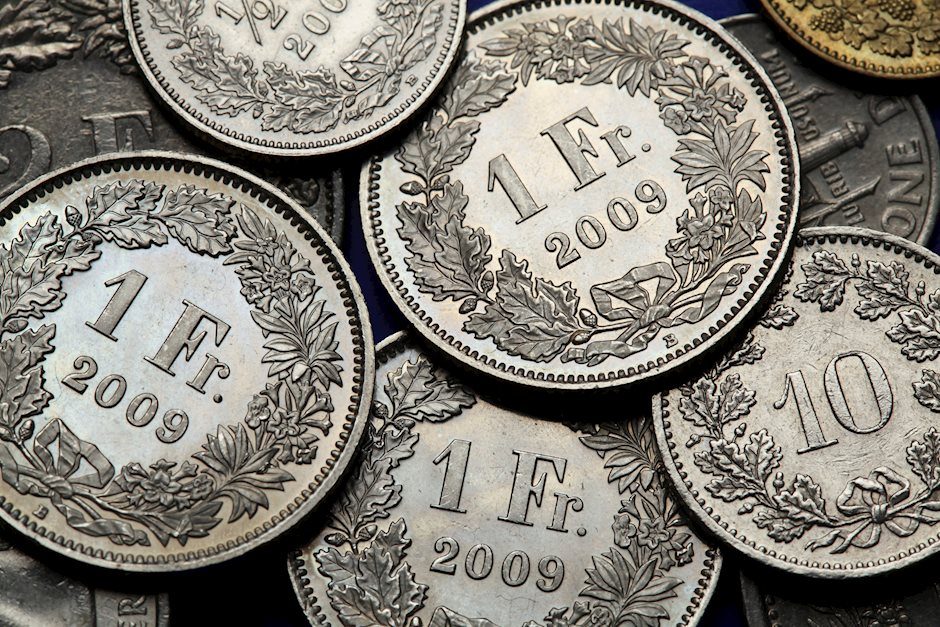Swiss Franc pares early gains as sentiment shifts
- The Swiss Franc pares early gains after a switch in market sentiment.
- The Franc had risen after the ZEW survey showed Swiss investors were optimistic about the economic outlook.
- The survey showed an increase in sentiment for the second month in a row.
- USD/CHF hits a key upside target and rolls over – potentially initiating a pullback.

The Swiss Franc (CHF) is trading lower on Wednesday after a shift in market sentiment and a broad-based rise in the US Dollar (USD). The Swiss Franc had traded higher in most key pairs during the early European session, after the release of a Swiss investor survey showed upbeat responses regarding the outlook for the Swiss economy for the second month in a row.
Swiss Franc gets boost after investor survey reflects optimism
The release of the Swiss ZEW Survey – Expectations for March showed investors were, on balance, positive in their responses, by a margin of 11.5, up from 10.2 in February.
The result marks the second positive month in a row after results fell and remained below zero in March 2022. The survey is thought to reflect investors’ optimism following the 0.25% reduction in interest rates by the Swiss National Bank (SNB) at its March meeting, according to Tradingeconomics.com.
Swiss ZEW Survey – Expectations: 5-year chart
Technical Analysis: Swiss Franc meets first target for breakout and pulls back
USD/CHF – the number of Swiss Francs that can be bought with one US Dollar (USD) – broke above the key 0.9000 level and reached a peak of 0.9063 on Wednesday, before rolling over.
The pair looks like it may be pulling back within an established short-term uptrend, which began after USD/CHF broke out of the range it had been trading in for most February and the first half of March.
US Dollar versus Swiss Franc: 4-hour chart
The pair has just reached the target of the range breakout at around 0.9050, calculated by taking the full height of the range and extrapolating it higher.
The Moving Average Convergence/ Divergence (MACD) indicator is showing bearish divergence with price at the recent peak when compared with the March 22 peak.
Although price continued rising, the MACD failed to. This is a sign of underlying weakness (circled).
The Relative Strength Index (RSI), another indicator, is sitting in overbought which is a sign traders should not add to their bullish bets. If it comes down and exits overbought it will be a signal to close bullish bets and short the pair.
If a pullback extends lower, it will probably first fall to support at the March 22 highs and the last higher high at 0.9020.
Beyond that, the pair is overall seen continuing the short-term uptrend that formed prior to the range and its breakout higher. The next target to the upside could be the 0.9100 round number level.
It would take a deeper slide below 0.8960 to bring into question the dominance of the uptrend and suggest the possibility of a reversal.
A break back inside the range, confirmed by a move below 0.8890, would be required to mark a short-term trend reversal and the start of a deeper slide.
The first target for such a move would be the range lows at roughly 0.8715.
Swiss economy FAQs
Switzerland is the ninth-largest economy measured by nominal Gross Domestic Product (GDP) in the European continent. Measured by GDP per capita – a broad measure of average living standards –, the country ranks among the highest in the world, meaning that it is one the richest countries globally. Switzerland tends to be in the top spots in global rankings about living standards, development indexes, competitiveness or innovation.
Switzerland is an open, free-market economy mainly based on the services sector. The Swiss economy has a strong export sector, and the neighboring European Union (EU) is its main trading partner. Switzerland is a leading exporter of watches and clocks, and hosts leading firms in the food, chemicals and pharmaceutical industries. The country is considered to be an international tax haven, with significantly low corporate and income tax rates compared with its European neighbors.
As a high-income country, the growth rate of the Swiss economy has diminished over the last decades. Still, its political and economic stability, its high education levels, top-tier firms in several industries and its tax-haven status have made it a preferred destination for foreign investment. This has generally benefited the Swiss Franc (CHF), which has historically kept relatively strong against its main currency peers. Generally, a good performance of the Swiss economy – based on high growth, low unemployment and stable prices – tends to appreciate CHF. Conversely, if economic data points to weakening momentum, CHF is likely to depreciate.
Switzerland isn’t a commodity exporter, so in general commodity prices aren’t a key driver of the Swiss Franc (CHF). However, there is a slight correlation with both Gold and Oil prices. With Gold, CHF’s status as a safe-haven and the fact that the currency used to be backed by the precious metal means that both assets tend to move in the same direction. With Oil, a paper released by the Swiss National Bank (SNB) suggests that the rise in Oil prices could negatively influence CHF valuation, as Switzerland is a net importer of fuel.
Author

Joaquin Monfort
FXStreet
Joaquin Monfort is a financial writer and analyst with over 10 years experience writing about financial markets and alt data. He holds a degree in Anthropology from London University and a Diploma in Technical analysis.
-638471314742002383.png&w=1536&q=95)


















